 Image search results - "kin" Image search results - "kin" |
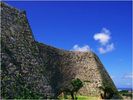
Nakagusuku Castle is part of a World Heritage Site of Okinawan gusuku castles. This is a view looking eastward from the base of the 3d enclosure (migusuku). Photos in this album all by Michael Lynch. Constructed in mid-fourteenth century of limestone rocks, placed without the use of mortar, Commodore Perry praised the construction technique on his visit to Okinawa in 1853.
|
|

World Heritage Marker. Photo copyright 2009 Michael Lynch.
|
|
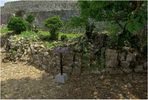
Sacred Site. There are eight special places of worship (Utaki) located within the castle walls. This view looks toward the East from the inside of the 1st enclosure. Photo copyright 2009 Michael Lynch.
|
|
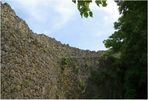
A view from the base of the West enclosure. Constructed in mid-fourteenth century of limestone rocks, placed without the use of mortar, Commodore Perry praised the construction technique on his visit to Okinawa in 1853. Photo copyright 2009 Michael Lynch.
|
|
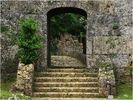
Rear Gate. Most visitors will enter through this gate to the castle, as it is closest to the parking and ticket sales. Photo copyright 2009 Michael Lynch.
|
|
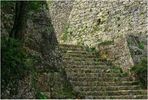
Stone Stairs. They lead to the 2nd enclosure. Visitors should wear sturdy walking shoes, as the stone-lined pathways and stairs can be very difficult to walk on without twisting an ankle. Photo copyright 2009 Michael Lynch.
|
|
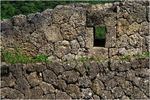
Gun Port. At several locations along the North walls of the castle, gun ports may be seen, where sentries could repel invaders. Photo copyright 2009 Michael Lynch.Many visitors are surprised to learn that firearms were in existence in the 14th century.
|
|
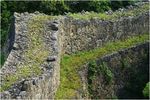
Terraced Walls. A view looking from north to south standing at an elevated point along the inner castle walls. Photo copyright 2009 Michael Lynch.
|
|

Three Sacred Sites. The South enclosure contains three Utaki (sacred sites), all within a small area, as seen by the signs in this picture. Many Okinawans come to worship at these Utaki and make offerings. Photo copyright 2009 Michael Lynch.From the high ground to the left of this scene, you may be able to see Kudaka-Jima, where locals believe the first Okinawans originated.
|
|

Boat for Taketomi at Ishigaki Port.
|
|
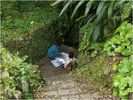
Sacred Well. There are three spring-fed wells within the castle. This one is located in the West enclosure and is also a sacred site where people make ritual offerings. Photo copyright 2009 Michael Lynch.The woman on the left gave consent to take a photo after helping her down the rough, stone stairs.
|
|

Road to Mt. Yukinoyama, an ancient mountain and home to over 200 tumuli built during the 5th to 7th centuries. In 2013, it was designated as a National Historic Site.
|
|

Several groups perform along the main road on the east side of JR Shinjuku Station. This is in front of Isetan Dept. Store.
|
|

During July-Aug. 2007, I helped to make the Yokaichi giant kite at the annex of the Yokaichi Giant Kite Museum.where the giant kite is made. Every three years, the giant kite, flown every May in Higashi-Omi, is replaced by a new kite bearing a new design.The new kite was made during July-Aug. 2007, taking about 30 days. The kite is made by volunteers from the public under the instruction of the Yokaichi Giant Kite Preservation Society. For the first time, I helped make this giant kite which was first flown successsfully on May 25, 2008 at the annual kite festival.
|
|

On Taketomi, the best way to get around.
|
|
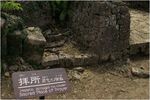
Utaki. A closeup view of a place of worship. Incense is sometimes burned and coins placed in the stone container centered within the utaki stone walls. Photo copyright 2009 Michael Lynch.
|
|

Approaching Kawamori. 川守
|
|

A large crowd watches as the crowd-pleasing drummers bring a bit of Okinawa to central Tokyo.
|
|

Entrance to the annex and a sign indicating the day's event or work. Today, July 7, 2007, was the Noritsuke Pasting Ceremony. 八日市大凧まつり のりつけ式
|
|
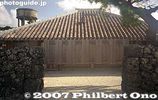
Okinawan house, Taketomi. Taketomi is a National Important Traditional Townscape Preservation District (重要伝統的建造物群保存地区).
|
|
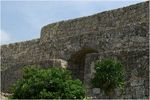
Second Enclosure. A view of the archway and stone construction from inside the 2nd enclosure, looking East. Photo copyright 2009 Michael Lynch.
|
|
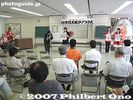
July 7, 2007: The making of the giant kite started with Noritsuke Pasting Ceremony where the new design was announced and dignitaries pasted together the first pieces of the kite paper.
|
|

Kawamori bus stop, nearest to Mt. Yukinoyama.
|
|

Many women drummers also perform. Shinjuku Eisa Matsuri, Tokyo
|
|
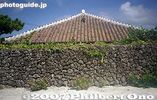
Okinawan house and rock wall, Taketomi
|
|

To Mt. Yukinoyama
|
|
|

Before announcing the final kite design, they announced the three best (but not winning) design entries. The public was invited to submit kite designs based on the theme of "Life" or inochi.
|
|

Lookout tower
|
|
|

Shinjuku Eisa Matsuri, Tokyo
|
|

Twenty-six design entries were submitted this year. There was no top winner, so the final design was based on the three best designs. This design features the kanji "Yorokobu" or joyfulness. 今回のテーマは「いのち」
|
|

On Taketomi, residential homes are toward the middle of the island, not along the beaches. The middle part of the island is built on hard rock called chert. Freshwater wells can be dug along this rock to provide water. View from lookout tower.
|
|
|
|

They introduced the three best designs. 最優秀作品はなく、3点の優秀賞作品を参考に保存会が決めた。
|
|
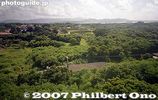
Outside the middle part of Taketomi, the ground is on limestone where water seeps through. Difficult to have rice paddies or wells on limestone.
|
|
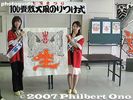
The new kite design was then announced. Called Han-jimon (判じもん), the design expresses a certain theme using word play with a pair of animals and one or two kanji characters. 八日市大凧は3年に一度図柄を変える。
|
|

Mt. Yukinoyama and Hino River 雪野山と日野川
|
|
|
|
|
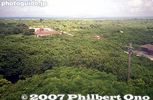
View from lookout tower
|
|

The top kanji is "yorokobu" (joyfulness) which can also be read as "ki." The pair of hawks 鷹 can be read as "yo." And the bottom kanji is "sei" (living). It's "Kyosei."
|
|

Mt. Yukinoyama and Hino River 雪野山と日野川
|
|
|
|
|
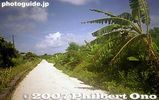
White coral road
|
|

Hino River 日野川
|
|

Hand drum
|
|

Higashi-Omi mayor Nakamura Koichi explains the design. "Kyosei" 共生 means to co-exist (i.e. man and nature) or to live together harmoniously. 中村功一市長
|
|
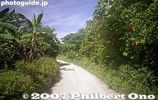
White coral road, one of Taketomi's trademarks.
|
|

Hino River 日野川
|
|
|
|

The mayor and one of the kite design artists wear a sash and pose for a picture before proceeding with the Noritsuke Ceremony.
|
|
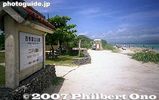
Kondoi Picnic Site
|
|
|

Infectious Okinawan beat. Shinjuku Eisa Matsuri, Tokyo
|
|

Mt. Mitake is one of Tokyo's easily accessible peaks via cable car. But it still requires a good deal of climbing up slopes and steps. You can also hike to adjacent Mt. Hinode-yama. Great daytrip getaway from Tokyo's concrete jungle.Getting off the train at Mitake Station on the JR Ome Line. I wasn't the only one who decided it was a good day to hike up Mitake. 御岳駅
|
|

Boundary between Ome city and Hinode-machi town. I was hiking from Mt. Mitake in neighboring Ome.
|
|

They used a wide brush to apply paste to the edges of a piece of kite paper.
|
|
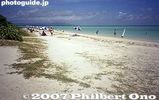
Kondoi beach
|
|

Mt. Yukinoyama and Ryuoji Temple. MAP
|
|
|

Mitake Station on the JR Ome Line. 御岳駅
|
|
|
|

They joined two sheets of kite paper together. This marked the first step in making the kite. The finished kite paper will consist of a few hundred washi paper sheets pasted together.
|
|
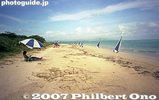
Be aware that these parasols are not free.
|
|
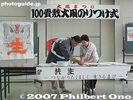
More dignitaries paste the sheets of kite paper together.
|
|

Ryuoji Temple 龍王寺
|
|
|

Very close to the summit of Hinode-yama. Only one lodge is here.
|
|
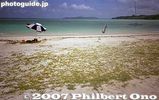
Kondoi beach
|
|

Ryuoji Temple 龍王寺
|
|
|

Mitake Station on the JR Ome Line. 御岳駅
|
|

Last flight of steps to the summit.
|
|

The pasted pieces are laid to dry.
|
|
|

Ryuoji Temple belongs to the Tendai Sect. 龍王寺
|
|
|

Bus stop for cable car station.
|
|
|

We were then invited to sign our names on the kite paper.
|
|
|

Ryuoji Temple 龍王寺
|
|

Dancing in front of JR Shinjuku Station, East side
|
|

Bus for cable car station.
|
|

Top of Mt. Hinode-yama
|
|

The kite design announcement and pasting ceremony lasted an hour, after which a group photo was taken.
|
|
|

Tenjin Shrine 天神社
|
|
|

Cable car station.
|
|

Top of Mt. Hinode-yama
|
|
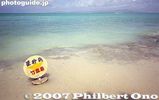
Hoshi Sunahama or Star Sand Beach
|
|

Tenjin Shrine, reconstructing the shrine. Ryuo-cho, Shiga. 天神社
|
|
|
|

Welcome to Mt. Mitake
|
|

Benches all over for us to gaze at the panorama.
|
|

Hiking trail on Mt. Yukinoyama.
|
|
|
|

Cable car for Mt. Mitake.
|
|

Alpine map pointing the way to various areas
|
|
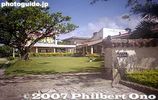
Taketomi Primary School
|
|

Mountain God Memorial 山の神
|
|

Smoking dragon dance
|
|

570 yen one way. There's also a lift for an extra 100 yen. No one rides the lift.
|
|
|
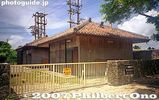
Power voltage station
|
|

Trail flanked by ferns
|
|

Okinoshima in sight
|
|
|

Cable car to Mt. Mitake
|
|

Mt. Hinode-yama summit has a little picnic pavilion
|
|

July 8, 2007: On the day after the pasting ceremony, the Kamitsugi or paper joining was next. 紙継ぎ
|
|
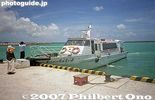
Taketomi Port boat for Ishigaki
|
|

Ferns
|
|

Misty Okinoshima
|
|
|

Mitake-san Station for cable car
|
|

Benches for hikers who had lunch.
|
|

Starting at 9:30 am, members of the giant kite preservation society began pasting and joining about 400 sheets of washi paper to make the giant kite paper.
|
|

Entering Okinoshima Port. Okishima is the largest island in Lake Biwa. MAP
|
|

Very popular festival and well-worth seeing.
|
|

Lookout deck near cable car station
|
|

Spectacular views from the top of Mt. Hinode-yama, Tokyo. But I couldn't recognize any landmarks.
|
|

The top two rows of washi sheets already pasted together.
|
|

1st lookout point, too many trees in the way.
|
|
|
|
|

View from lookout deck on Mt. Mitake, Tokyo
|
|

Views from the top of Mt. Hinode-yama, Tokyo
|
|

The size of the room almost exactly matches the size of the giant kite which is 12 meters by 13 meters or 100 tatami mats.
|
|
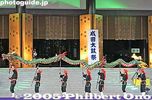
Taiko troupe from OkinawaThis group stole the show with a dragon dance, lion dogs, and eisa taiko drummers.
|
|

View from Yukinoyama
|
|

Side of boat
|
|
|
|

Views from the top of Mt. Hinode-yama, Tokyo
|
|

The paper is Mino Washi, from Gifu Prefecture. It is white, and surprisingly thin. I thought it would be thicker. Six or so sheets are stacked while slightly spread apart.
|
|
|

View of Ryuo-cho town from Mt. Yukinoyama.
|
|

Okinoshima Port
|
|

Mt. Hinode-yama which is next to Mt. Mitake.
|
|

Views from the top of Mt. Hinode-yama. The large white building is the Seibu baseball dome in Tokorozawa.
|
|

The stacked paper is put on a table where water-based paste is applied to one horizontal and one vertical paper edge.
|
|
|

Map of hiking trails on Yukinoyama. It takes about 90-120 min. to go up and down the mountain. There are some fine views from the trails.
|
|

2nd lookout point 第二展望台
|
|

Okinoshima Port and boat schedule
|
|

Lift station in middle (very short distance) which no one rides.
|
|

Surrounding mountains in pastel colors
|
|

Each person holds one edge-pasted sheet and line up to align and join the sheet. Each sheet measures about 90 cm by 60 cm. There are also half-size sheets.
|
|
|
|

Top of Yukinoyama at 308 meters elevation. The views are obstructed by many trees. 雪野山 頂上
|
|

Okishima Port
|
|

Welcome Gate. Everyone goes through here instead and walk toward the top.
|
|
|
|

Anybody can help do this. The public is invited to sign their names on a sheet and paste it to the big kite paper.
|
|
|

Top of Yukinoyama. 雪野山 頂上
|
|

Sea wall
|
|

Back of welcome gate.
|
|

Trail to go down
|
|

The sheets are joined in the same pattern as a brick wall. Every other row of sheets has a half sheet along the edge. Notice the autographs of people on the paper.
|
|
|
|

View from top of Yukinoyama
|
|
|

Torii ahead. Mt. Mitake is topped with a Shinto shrine.
|
|

Going down
|
|

So the giant kite is actually made of many smaller sheets of paper joined together. Notice my "philbert" autograph on the bottom.
|
|
|
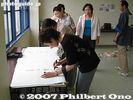
People sign their names on a washi sheet.
|
|

View from top of Yukinoyama
|
|
|

Torii
|
|
|
|
|
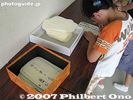
There are also smaller sheets of paper where you can write a wish and sign your name. Paste will be applied to these sheets which will be used to fasten the bamboo frame to the giant paper.
|
|

View from top of Yukinoyama
|
|

Shore road
|
|

Back of torii
|
|
|
|

View from top of Yukinoyama
|
|

Steps to the larger hill
|
|
|
|

The work proceeds.
|
|
|
|
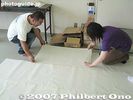
The last sheet is pasted and joined. The job was finished in 3 hours.
|
|
|

Neck of Okishima.
|
|

Hailstones in Feb.
|
|
|
|

Okinoshima Port
|
|

Hinode-yama, my target after Mt. Mitake.
|
|
|

The giant kite paper is finished, taking up the floor space of the entire room.
|
|
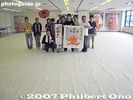
After every kite-making session, they take a picture of all the volunteer participants. It was very interesting. Anybody can participate on any day. Call the kite museum for schedule details: 0748-23-0081.
|
|

This trail was much more scenic.
|
|

Narrow alley
|
|

Bird house
|
|

Lots of steps, glad I was going down instead of up.
|
|

Ryuo-cho town as seen from Yukinoyama
|
|

Renmyo was here.
|
|
|
|

July 16, 2007: Initial sketching and vermilion painting. A sketch of the design was made with a charcoal pencil. 下絵・墨
|
|
|
|

Mt. Mitake Visitors Center where you can get maps and hiking advice.
|
|

Lots of trees.
|
|

The giant kite's main and largest kanji character "sei" is painted in vermilion.
|
|

Looking toward Higashi-Omi.
|
|
|

Inside Visitors Center
|
|

Fork in the road. Turned left for the waterfall trail.
|
|

A plastic bucket (the same kind used when you take a bath) with paint and a brush is used.
|
|

Water barrels in case of fire.
|
|
|
|

Old minka house on Mt. Mitake, Tokyo
|
|

Log bridge
|
|
|

My video of Okinawan dances like yotsudake and a karate dance.
|
|
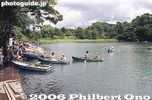
Goshikinuma is a chain of five colorful volcanic ponds. Pleasant hiking trails lead to the ponds. Part of the Bandai-Asahi National Park. Bishamon-numa Pond is the largest of the five and it has rental rowboats. 毘沙門沼
|
|

Trail going down the middle of the mountain.
|
|
|

Mitake-san Youth Hostel. The mountain has many lodges and inns.
|
|
|
|

Yotsudake, Okinawa's most famous dance. 四つ竹
|
|
|
|

View of central Ryuo-cho town from Mt. Yukinoyama.
|
|

Leaving Okinoshima (we'll be back).
|
|

Slope up
|
|

Pine cone
|
|

The red and ornage colors are painted first on the kite, while the black and gray colors are painted later.
|
|

Dancer: Nariko Miyagi
|
|

Colorful koi carp fish in Bishamon-numa Pond, Fukushima Pref. 毘沙門沼Bandai-Asahi National Park
|
|
|
|
|

Thatched roof
|
|

Okuno village was here.
|
|
|
|

Okinawan kimono called the bingata, perhaps Okinawa's most famous kimono. The design is made by applying dyes through a stencil.It was originally worn by Okinawa's royal family members. It is now the costume of a slow-moving Okinawan dance called "Yotsudake."
Model: Maki Uyeunten
|
|

Bishamon-numa Pond, Fukushima Pref. Bandai-Asahi National Park 毘沙門沼
|
|

Back view of yotsudake dancers on stage.
|
|

Ferns
|
|

Misty Omi-Hachiman coast
|
|

Mt. Mitake, Tokyo
|
|

Beware of bears...
|
|
| 3194 files on 13 page(s) |
1 |
 |
 |
 |
 |
|